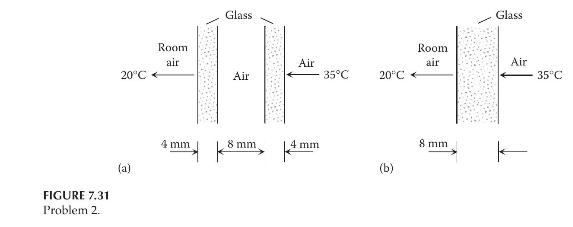Consider heat transfer through a double-pane window as shown in Figure 7.31a. Two layers of glass with
Question:
Consider heat transfer through a double-pane window as shown in Figure 7.31a. Two layers of glass with thermal conductivity \(k_{1}\) are separated by a layer of stagnant air with thermal conductivity \(k_{2}\). The inner surface of the window is at temperature \(T_{1}\) and exposed to room air with heat transfer coefficient \(h_{1}\). The outer surface of the wall is at temperature \(T_{2}\) and exposed to air with heat transfer coefficient \(h_{2}\). Assume that \(k_{1}=0.95 \mathrm{~W} /\left(\mathrm{m} \cdot{ }^{\circ} \mathrm{C}\right), k_{2}=0.0285 \mathrm{~W} /\left(\mathrm{m} \cdot{ }^{\circ} \mathrm{C}\right)\), \(h_{1}=h_{2}=10 \mathrm{~W} /\left(\mathrm{m}^{2 .}{ }^{\circ} \mathrm{C}\right), T_{1}=20^{\circ} \mathrm{C}\), and \(T_{2}=35^{\circ} \mathrm{C}\). The thickness of each glass layer is \(4 \mathrm{~mm}\), the thickness of the air layer is \(8 \mathrm{~mm}\), and the cross-sectional area of the window is \(1.5 \mathrm{~m}^{2}\).
a. Determine the heat flow rate through the double-pane window.
b. Determine the temperature distribution through the double-pane window.
c. Repeat Parts (a) and (b) for the single-pane glass window shown in Figure 7.31b.

Step by Step Answer:

Modeling And Analysis Of Dynamic Systems
ISBN: 9781138726420
3rd Edition
Authors: Ramin S. Esfandiari, Bei Lu





